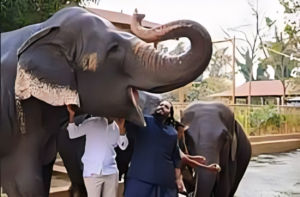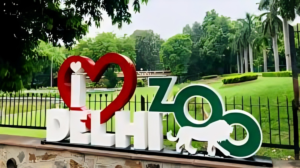Anant Ambani’s Bold Move: Partnering with Delhi’s National Zoological Park
Introduction
Anant Ambani, the youngest scion of India’s most prominent business family, has once again captured headlines with a venture that marries philanthropy and conservation. Building on his growing portfolio of sustainable initiatives, Anant has announced a collaboration with the Delhi National Zoological Park—an alliance designed to elevate wildlife preservation, community engagement, and educational outreach. This article explores the motivations, objectives, and potential impact of this partnership, offering insights into how private leadership can shape India’s conservation landscape.

The Vision Behind the Collaboration
Anant Ambani’s dedication to environmental causes has been evident through initiatives focusing on clean energy and rural development. His decision to join forces with the Delhi Zoo reflects a broader vision:
- Enhancing Animal Welfare: Upgrading enclosures and veterinary facilities to ensure world-class standards.
- Promoting Education: Launching interactive learning modules for schoolchildren and college students.
- Engaging Communities: Involving local residents in conservation efforts, from habitat restoration to citizen science.
Through this partnership, Anant aims to demonstrate that business leaders can play a pivotal role in safeguarding biodiversity, fostering a sense of stewardship among India’s youth, and setting a replicable model for other zoological parks.
Key Components of the Initiative
1. Infrastructure and Habitat Upgrades
- Modern Enclosures: Designing spacious, naturalistic habitats that mimic the native ecosystems of the species housed.
- Healthcare Facilities: Establishing a cutting-edge veterinary wing equipped with advanced diagnostic and treatment tools.
- Sustainable Operations: Implementing rainwater harvesting, solar panels, and waste recycling to minimize the zoo’s carbon footprint.
2. Educational Outreach Programs
Anant’s team is developing interactive experiences to cultivate conservation awareness:
- Digital Learning Hubs: Touchscreen kiosks and augmented-reality displays to explain animal behavior and conservation challenges.
- School Partnerships: Collaborative workshops, field trips, and teacher-training sessions to integrate wildlife conservation into the curriculum.
- Youth Ambassador Scheme: Empowering students to lead community drives, wildlife surveys, and social media campaigns.
3. Community Engagement and Citizen Science
- Local Stewardship Councils: Committees of residents and volunteers to monitor local biodiversity and report sightings.
- Conservation Camps: Weekend camps where families can participate in tree planting, clean-up drives, and habitat restoration.
- Open-Data Platforms: A publicly accessible database of wildlife observations to aid researchers and policymakers.

Real-Life Examples and Anticipated Impact
To illustrate the potential of such collaborations, consider similar global efforts:
- London Zoo and GSK Partnership: Funded research into animal health, leading to breakthroughs in treating captive and wild populations.
- Singapore Zoo’s Rainforest KidzWorld: A children’s area that educates through play, resulting in a measurable increase in community-led clean-up drives.
By adapting these models to India’s context, Anant Ambani’s initiative is expected to:
- Boost Visitor Engagement: More interactive features are likely to increase footfall, generating revenue for further conservation projects.
- Improve Animal Health Metrics: Enhanced medical care can reduce mortality rates and improve breeding success.
- Mobilize Grassroots Action: Empowered citizens can become ambassadors for their local ecosystems, multiplying the impact beyond zoo boundaries.
Challenges and Mitigation Strategies
Every ambitious project faces hurdles. Anant’s team is proactively addressing potential obstacles:
| Challenge | Mitigation Strategy |
|---|---|
| Funding Sustainability | Establish an endowment fund and corporate sponsorships. |
| Community Resistance | Conduct regular town-hall meetings to ensure transparency and local buy-in. |
| Operational Complexity | Partner with wildlife NGOs and academic institutions for expertise. |
Short, disciplined planning cycles and clear performance metrics will ensure that each component stays on track, fostering accountability and continuous improvement.
Measuring Success: KPIs and Long-Term Goals
To gauge the initiative’s effectiveness, the following Key Performance Indicators (KPIs) have been identified:
- Visitor Satisfaction Scores: Targeting a 20% increase within the first year.
- Educational Outreach Reach: Engaging 50,000 students across Delhi schools within two years.
- Wildlife Health Index: Improving average animal health ratings by 15% over 18 months.
- Community Participation: Recruiting 5,000 citizen scientists in the first 12 months.
These quantifiable goals will be revisited quarterly, ensuring that the initiative remains aligned with its core mission and adapts to emerging challenges.
Conclusion
Anant Ambani’s collaboration with the Delhi National Zoological Park represents a pioneering step in Indian conservation leadership. By integrating infrastructure upgrades, educational innovation, and community-driven science, the partnership offers a holistic blueprint for modern zoological parks. As this initiative unfolds, it holds the promise of not only enriching the lives of captive animals but also cultivating a generation of conservation champions across India. Ultimately, this endeavor underscores the transformative potential when visionary individuals leverage their resources for the greater good.